Hulu Business Model Canvas 2024
Hulu was initially called “The Biggest Loser,” but it changed at the last minute before launch. It turns out it wasn’t a loser and became one of the most prominent players in the streaming market. We will learn about its customer segments, value proposition, revenue streams, channels, customer relationships, key activities, key resources, key partners, and cost structure in this Hulu business model.
Interesting fact!
Hidden inside the Hulu screening room is a secret door leading to an exclusive speakeasy-style bar reserved for celebrity guests and VIPs.
Hulu Competitors
Netflix | Amazon Prime Video | Disney+ | Apple TV+ | YouTube TV | Sling TV | fuboTV | Paramount+ | HBO Max | Peacock
Customer Segments – Hulu Business Model Canvas
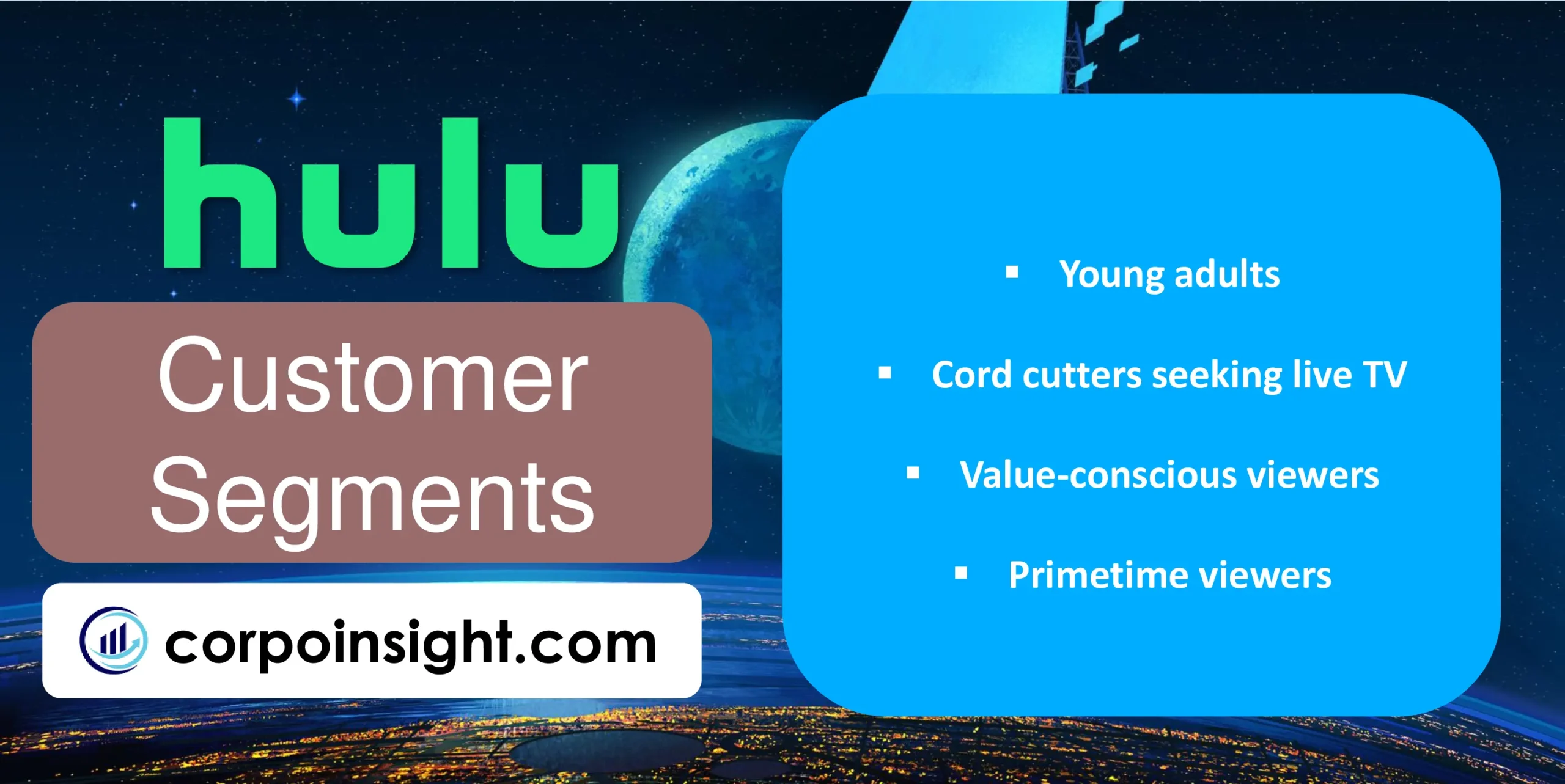
Young adults: Hulu attracts younger viewers, with around 60% of subscribers between 18-34 years old. This is likely driven by Hulu carrying current shows shortly after airing, appealing to young audiences looking to stay up to date. Popular shows in this segment include Family Guy, Brooklyn Nine-Nine, and South Park.
Cord-cutters seeking live TV: Approximately 72% of Hulu’s subscribers are “cord-cutters” without traditional TV subscriptions. Features like Hulu + Live TV allow these viewers access to live news, sports, and more for cheaper than cable. In 2023, Hulu + Live TV made up around 4 million of Hulu’s total 43.8 million subscribers.
Value-conscious viewers: Hulu’s ad-supported plan offers subscribers entertainment for just $7.99 per month. This attracts budget-conscious customers seeking cheap streaming. Even those that upgrade cite value as a leading motivator – access to new movie releases like Prey is seen as a better deal than renting or going to theaters.
Primetime viewers: Over 75% of Hulu subscribers say they mainly use the service to watch primetime TV shows. Next-day streaming of networks like ABC, Fox, and NBC is a major draw for fans wanting timely access to hits such as Abbott Elementary and 9-1-1. This allows viewership without expensive cable bundles.
Value Proposition – Hulu Business Model Canvas

Instant access to popular shows: Over 85% of Hulu subscribers cite immediate access to broadcast series as a top reason to subscribe. Hulu offers next-day streaming of current ABC, Fox, and NBC shows. This means subscribers can watch hit primetime series like The Bachelor and 9-1-1 less than 24 hours after airing.
Robust content library: With thousands of TV episodes, Hulu builds value by combining timely shows with an extensive back catalog. Viewers can binge nostalgic comedies like Golden Girls while also watching the latest season of It’s Always Sunny in Philadelphia. In 2023, Hulu onboarded over 73,000 additional TV episodes to continue expanding options.
Original programming: Though second to its studio catalog, Hulu invests heavily in acclaimed originals to attract viewers. Series like The Handmaid’s Tale, Little Fires Everywhere, and Only Murders in the Building drive subscriptions. In 2021 alone, Hulu Originals won 48 Emmy nominations.
Live TV options: For under $70 per month, subscribers can upgrade to Hulu + Live TV and stream live news, sports, and entertainment previously only accessible through cable bundles costing over $100 monthly. This allows greater flexibility and value for viewers.
Revenue Streams – Hulu Business Model Canvas
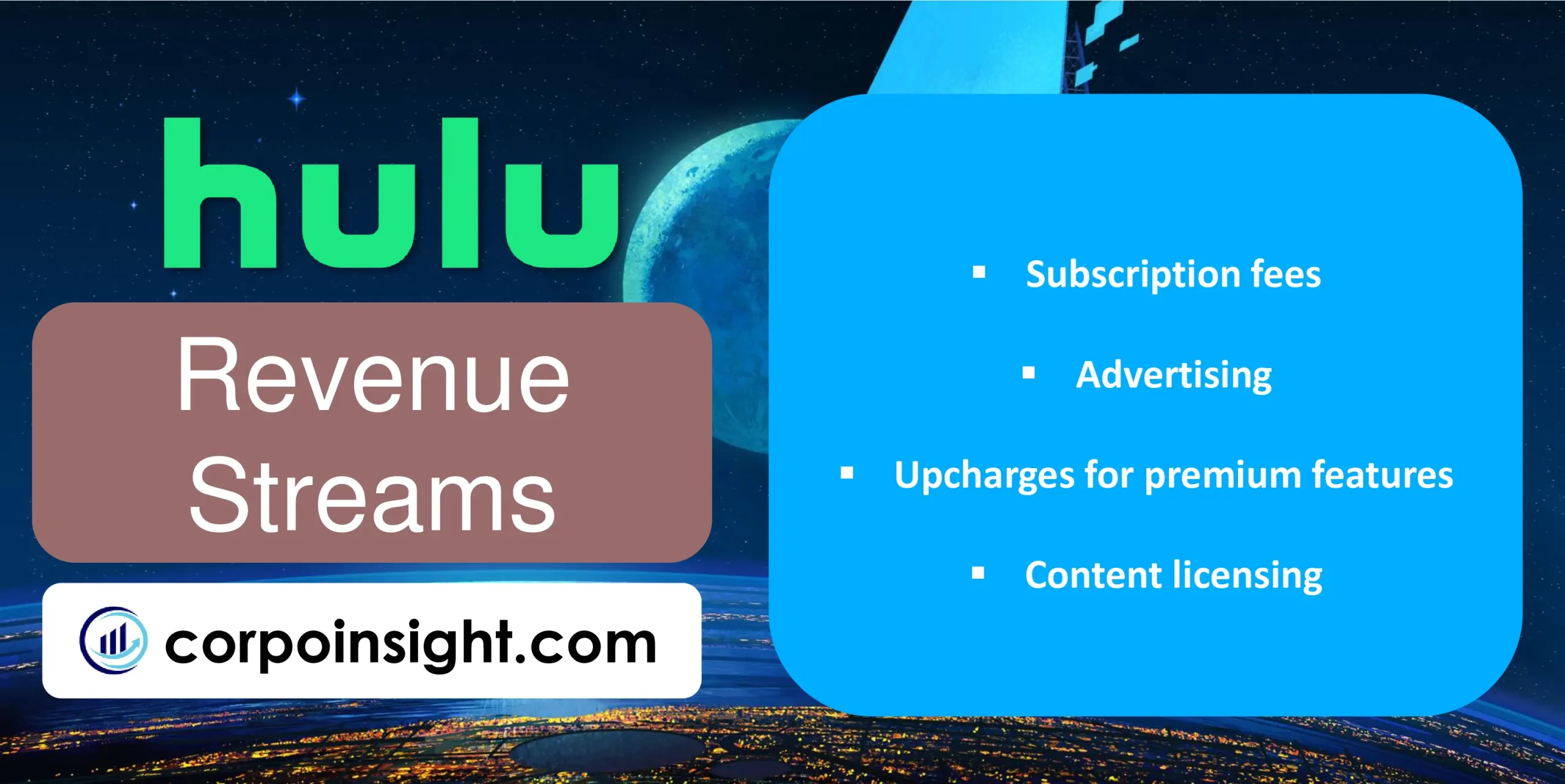
Subscription fees: Hulu generates over $4 billion in annual revenue, predominantly from monthly subscription fees across their various streaming plans. This includes $7.99/month for ad-supported Hulu, $14.99/month for the ad-free plan, and higher prices for bundle options like Hulu + Live TV.
Advertising: Despite competition from ad-free platforms, over 75% of Hulu subscribers opt into their ad-supported plan. This results in over $1 billion in annual ad revenue. Hulu offers differentiated targeting capabilities based on its data and content offerings, attracting major industry brands.
Upcharges for premium features: Viewers can pay to stream Hulu across unlimited devices or download content to watch offline for $9.99/month. Features like enhanced DVR and simultaneous streaming also command higher prices within Hulu + Live TV plans, incremental to the base package cost.
Content licensing: While secondary to subscriptions, Hulu also earns revenue by licensing certain distribution rights to third parties. Hulu has inked international distribution deals for original programming like The Handmaid’s Tale and Ramy.
Channels – Hulu Business Model Canvas
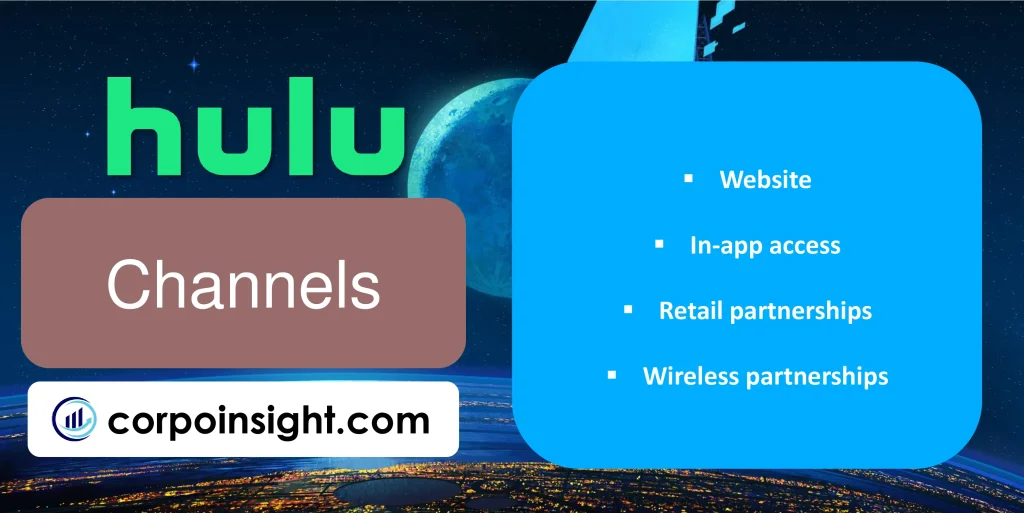
Website: Over 85% of subscribers directly sign up for Hulu on their website, Hulu.com, to access streaming content. The site allows clear communication of Hulu’s value proposition, content library, free trials for acquisition, and subscription purchase flow.
In-app access: Viewers can download dedicated Hulu apps across mobile devices, smart TVs, gaming consoles, and more for convenient in-app subscription and streaming. This includes partnerships covering over 90% of connected TVs – like popular platforms Roku, Fire TV, and Apple TV.
Retail partnerships: While diminishing for streaming broadly, gift cards through physical retailers still help expand Hulu’s audience. Over 65,000 retail locations, including Walmart, Best Buy, and more, sell Hulu gift subscriptions to enhance accessibility and gifting for seasonal occasions.
Wireless partnerships: As of 2023, over 30 major U.S. wireless companies embed or bundle Hulu into mobile plans, including AT&T, Verizon, and T-Mobile, to drive subscriber acquisition. These reduced-cost partnerships allow wireless companies to add media value.
Customer Relationships – Hulu Business Model Canvas

Personalized recommendations: Hulu refines content suggestions to subscribers’ interests using viewing data. This drives 76% of account activity from recommendations versus just 24% from search, creating an intuitive, personalized experience that helps retain viewers.
Self-service troubleshooting: Through Hulu’s help center, subscribers can quickly access FAQs, how-to articles, and community forums for service issues. This allows self-service for over 60% of troubleshooting cases, improving satisfaction and lowering support costs.
Proactive retention: Hulu employs advanced analytics to identify subscribers at risk of canceling service. They then make special offers, such as free trial extensions or temporary discounts, to retain those accounts and relationships.
Social media engagement: Hulu community managers actively respond to subscriber commentary and feedback across Twitter, Facebook, and Instagram. During high-volume conversations like new original show launches, they connect directly with several hundred customers daily.
Key Activities – Hulu Business Model Canvas

Content licensing: Hulu spends over $2 billion annually licensing streaming rights from major networks and studios. This allows next-day access to shows from NBC, Fox, and more, plus films from Disney, Universal, and others to fuel Hulu’s extensive on-demand catalog.
Original productions: Hulu invests over $500 million annually in creating acclaimed original series that drive subscriptions like The Handmaid’s Tale, Little Fires Everywhere, and Nine Perfect Strangers. Originals account for 10+ Emmy wins, building brand prestige.
Aggregating live TV: To power Hulu + Live TV, deals are struck to supply over 75 live channels plus cloud DVR storage and features. Monthly costs to deliver these services exceed $50 per subscriber, creating thin margins offset by subscription revenues.
Technology development: Hulu operates complex cloud infrastructure while regularly optimizing apps across diverse devices, from smartphones to game consoles. Over 15% of the workforce focuses on building internal tools supporting key streaming capabilities that enable reliable, high-quality viewing.
Key Resources – Hulu Business Model Canvas

Content library: With over 100,000 TV episodes and 3,200+ movies licensed on-demand, Hulu’s video catalog depth compels subscriptions. Maintaining breadth through new licensing deals while retaining legacy content rights requires continued investment measured in billions.
Production capabilities: Hulu has built internal studios focused on developing original shows anchored by experienced industry creative talent and producers. Originals now make up over 10% of viewing, representing an owned asset differentiating Hulu in the streaming market.
Viewer data: With over 43 million total subscribers as of 2023, Hulu gains tremendous data on content preferences, fueling personalization algorithms that drive engagement. Advanced analytics also inform subscriber targeting and retention initiatives for growth.
Partnerships: Hulu cultivates partnerships with wireless carriers, device makers, and more, providing market development. Most notably, close Disney ownership unlocks valuable IP access, global infrastructure, and bundled sales reach unique to Hulu.
Key Partners – Hulu Business Model Canvas
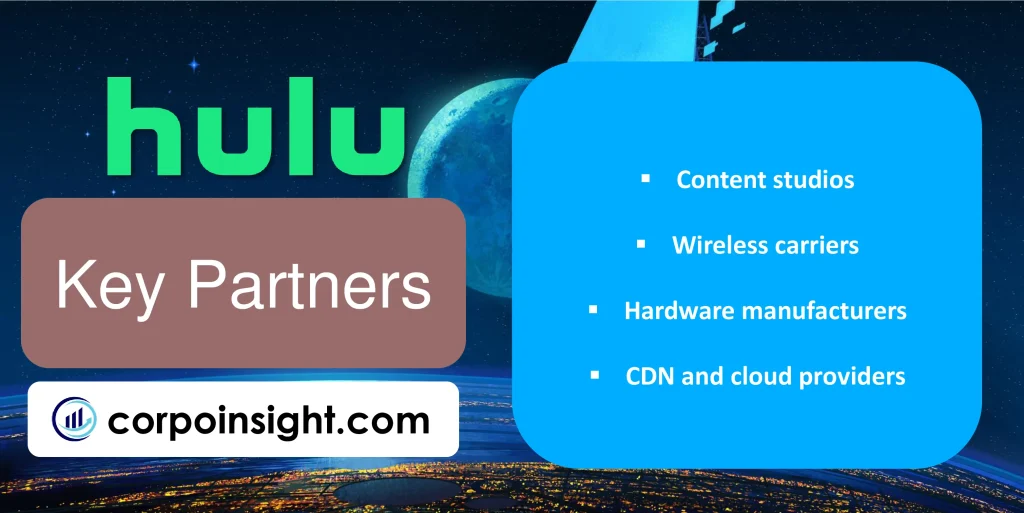
Content studios: Hulu licenses streaming rights from studios like Disney, NBCUniversal, Warner Bros., and more to access valuable film and TV assets. Hulu reportedly spends over $2 billion annually across multi-year studio deals fueling catalog breadth.
Wireless carriers: Partnerships with Verizon, T-Mobile, and most other significant carriers allow bundled Hulu access to drive subscriber acquisition at reduced prices. These deals increase Hulu’s market reach to non-streaming audiences.
Hardware manufacturers: Embedding Hulu across devices from Roku, Apple, and various smart TV operating systems expands availability in internet-connected homes. Over 90% of US-connected TVs provide native access.
CDN and cloud providers: To deliver reliable global streaming, Hulu leverages 3rd party networks like Akamai and cloud from AWS, which host, process, and distribute content. Given the volatility, multi-provider redundancy protects uptime.
Cost Structure – Hulu Business Model Canvas

Content licensing: The largest expense for Hulu is multi-year, multi-million dollar streaming deals with major studios like Disney, Warner Bros., and NBCUniversal to access valuable film and TV assets. As competition rises, so do prices.
Infrastructure costs: With 43.8 million subscribers streaming over 100 billion minutes annually by 2023, Hulu incurs over $500 million in just CDN and cloud infrastructure to reliably host and distribute content globally while handling huge demand.
Marketing: To attract new subscribers, Hulu allows hundreds of millions per year in advertising across TV, digital platforms, and retail partnerships. Subscriber acquisition costs can account for up to 20% of annual budgets.
Originals production: While owning the IP rights, Hulu original shows also come at a premium, with total investments exceeding $500 million annually when factoring in elevated talent fees attached to prestigious projects.
Summary of Hulu Business Model Canvas
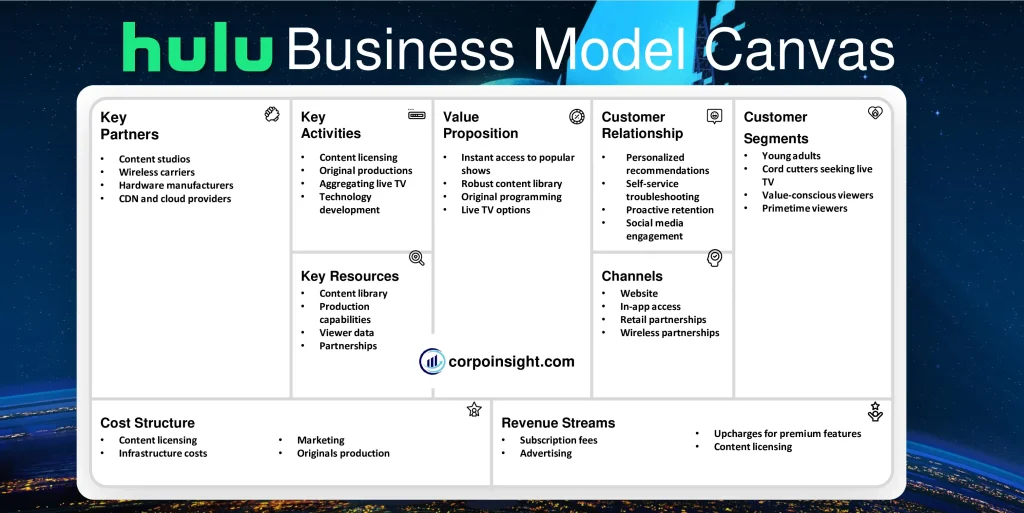
Conclusion on Hulu Business Model Canvas
Hulu has built a profitable, high-growth streaming business by utilizing a strong content catalog spanning licensed shows, movies, and originals to appeal to a broad subscriber base. Supported by key partnerships for distribution and fueled by multi-billion investments in rights acquisitions, productions, and cloud infrastructure, Hulu delivers clear consumer value with current programming, advertiser opportunities, and options catering to every entertainment enthusiast.

This is Ahsanul Haque, someone very passionate about digital marketing, SEO, and Data Analytics and founder of the Analytics Empire and currently pursuing my major in marketing at Bangladesh University of Professionals.







